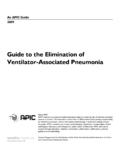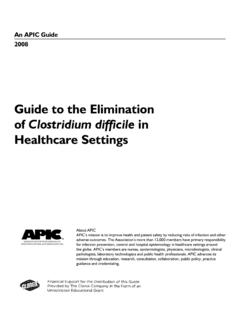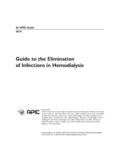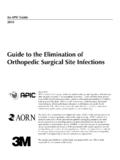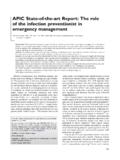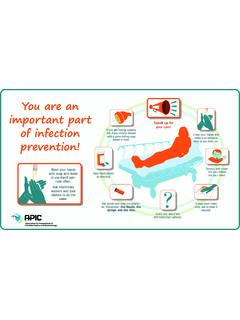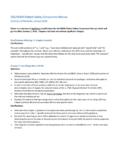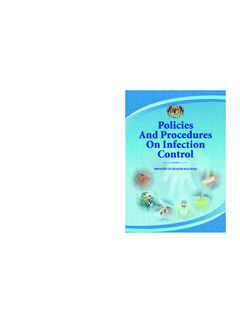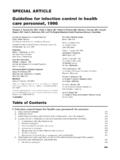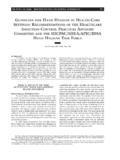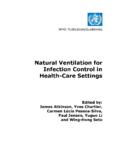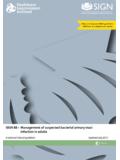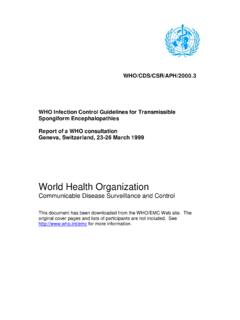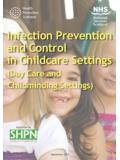Transcription of SHEA/APIC Guideline: Infection prevention and …
1 SHEA/APIC Guideline: Infection prevention and controlin the long-term care facilityPhilip W. Smith, MD,aGail Bennett, RN, MSN, CIC,bSuzanne Bradley, MD,cPaul Drinka, MD,dEbbing Lautenbach, MD,eJames Marx, RN, MS, CIC,fLona Mody, MD,gLindsay Nicolle, MD,hand Kurt Stevenson, MDiJuly 2008 Long-term care facilities (LTCFs) may be defined asinstitutions that provide health care to people whoare unable to manage independently in the care may be chronic care management orshort-term rehabilitative services. The termnursinghomeis defined as a facility licensed with an organizedprofessional staff and inpatient beds that providescontinuous nursing and other services to patientswho are not in the acute phase of an illness. There isconsiderable overlap between the 2 than million residents reside in UnitedStates (US) nursing homes. In recent years, the acuityof illness of nursing home residents has residents have a risk of developing health care-associated Infection (HAI) that approaches that seen inacute care hospital patients.
2 A great deal of informationhas been published concerning infections in the LTCF,and Infection control programs are nearly universal inthat setting. This position paper reviews the are developed for long-term care(LTC) Infection control programs based on interpreta-tion of currently available evidence. The recommenda-tions cover the structure and function of the infectioncontrol program, including surveillance, isolationprecautions, outbreak control , resident care, andemployee health. Infection control resources are Infection control programs are well estab-lished in the US. Virtually every hospital has an infec-tion control professional (ICP), and many largerhospitals have a consulting hospital Study on the Efficacy of Nosocomial InfectionControl (SENIC) documented the effectiveness of a hos-pital Infection control program that applies standardsurveillance and control major elements leading to a HAI are the infec-tious agent, a susceptible host, and a means of trans-mission.
3 These elements are present in LTCFs as wellas in hospitals. It is not surprising, therefore, thatalmost as many HAIs occur annually in LTCFs as inhospitals in the last 2 decades have seen increased recognitionof the problem of infections in LTCFs, with subsequentwidespread development of LTCF Infection control pro-grams and definition of the role of the ICP in increasingly robust literature is devoted to LTCinfection control issues such as the descriptive epide-miology of LTCF infections , the microbiology of LTCF infections , outbreaks, control measures, and , there is as yet no SENIC-equivalent studyProfessor of Infectious Diseases, Colleges of Medicine and PublicHealth, University of Nebraska Medical Center, Omaha, Nebraskaa;President, ICP Associates, Inc, Rome, Georgiab; Professor of InternalMedicine, Divisions of Infectious Diseases and Geriatric Medicine VAAnn Arbor Healthcare System, and the University of Michigan MedicalSchool, Ann Arbor, Michiganc; Clinical Professor, Internal Medicine/Ger-iatrics, University of Wisconsin-Madison, and Medical College of Wis-consin Milwaukee, Wisconsind; Associate Professor of Medicine andEpidemiology, Associate Hospital Epidemiologist, Hospital of the Uni-versity of Pennsylvania, and Senior Scholar, Center for Clinical Epidemi-ology and Biostatistics, University of Pennsylvania School of Medicine,Philadelphia, Pennsylvaniae; Infection Preventionist, Broad Street Solu-tions, San Diego, Californiaf.
4 Assistant Professor, Divisions of GeriatricMedicine, University of Michigan Medical School, and Geriatric Re-search and Education Center, Veteran Affairs Ann Arbor HealthcareSystem, Ann Arbor, Michigang; Professor, Internal Medicine and MedicalMicrobiology, University of Manitoba, Winnipeg, Manitoba, Canadah;and Associate Professor of Medicine, Division of Infectious Diseases,Department of Internal Medicine, The Ohio State University Collegeof Medicine, Columbus, correspondence to Philip W. Smith, MD, Section of InfectiousDisease, University of Nebraska Medical Center, 985400 NebraskaMedical Center, Omaha, NE J Infect control 2008;36 $ 2008 by the Association for Professionals in InfectionControl and Epidemiology, Inc, and Society for the efficacy of Infection control in LTCFs,and few controlled studies have analyzed the efficacyor cost-effectiveness of the specific control measuresin that hospitals and LTCFs both have closedpopulations of patients requiring nursing care, theyare quite different.
5 They differ with regard to pay-ment systems, patient acuity, availability of labora-tory and x-ray, and nurse-to-patient ratios. Morefundamentally, the focus is different. The acutecare facility focus is on providing intensive care toa patient who is generally expected to recover or im-prove, and high technology is integral to the LTCFs, the patient population may be very heter-ogeneous. Most LTCFs carry out plans of care thathave already been established in acute care or eval-uate chronic conditions. The LTCF is functionally thehome for the resident, who is usually elderly and indeclining health and will often stay for years, hencecomfort, dignity, and rights are paramount. It is alow-technology setting. Residents are often trans-ferred between the acute care and the LTC setting,adding an additional dynamic to transmission andacquisition of of hospital Infection control guidelines tothe LTCF is often unrealistic in view of the differencesnoted above and the different Infection control re-sources.
6 Standards and guidelines specific to the LTCF setting are now commonly found. The problem of devel-oping guidelines applicable to all LTCFs is compoundedbythevaryinglevelsofnursingint ensity(eg,skillednurs-ing facility vs assisted living), LTCF size, and access tophysician input and diagnostic position paper provides basic Infection controlrecommendations that could be widely applied toLTCFs with the expectation of minimizing HAIs inLTC. The efficacy of these measures in the LTCF, inmost cases, is not proven by prospective controlledstudies but is based on Infection control logic, adapta-tion of hospital experience, LTCF surveys, Centers forDisease control and prevention (CDC) and other guide-lines containing specific recommendations for LTCFs,and field experience. Every effort will be made toaddress the unique concerns of LTCFs. Because facili-ties differ, the Infection risk factors specific to theresident population, the nature of the facility, and theresources available should dictate the scope and focusof the Infection control a number of instances, specific hospital-orientedguidelines have been published and are referenced(eg, guidelines for prevention of intravascular (IV)device-associated Infection ).
7 These guidelines arerelevant, at least in part, to the LTC setting but may beadapted depending on facility size, resources, residentacuity, local regulations, local Infection control issues,etc. Reworking those sources to a form applicable toall LTCFs is beyond the scope of this discussion of Infection control issues must bemade in the context of the LTCF as a community. TheLTCF is a home for residents, a home in which theyusually reside for months or years; comfort andinfection control principles must both be and definitionsThe US population aged 65 to 85 years is increasingrapidly, and the population aged 85 years and older isexpected to double by of every 4 personswho reach the age of 65 can be expected to spendpart of his or her life in a nursing home; more peopleoccupy nursing home beds than acute care hospitalbeds in the million personsin the US reside in a nursing home; there are 15,000nursing homes in this percent of nurs-ing home residents are over 65 years of age, and themean age of residents is over 80 LTCF is a residential institution for providing nurs-ing care and related services to residents.
8 It may beattached to a hospital (swing-bed) or free standing;the latter is often called anursing home. A resident isa person living in the LTCF and receiving care, analo-gous to the patient in a of position paperThis position paper addresses all levels of care in theLTCF. The focus is specifically the LTCF, also known asthenursing home, caring for elderly or chronically illresidents. These recommendations generally alsoshould apply to special extended care situations(such as institutions for the mentally retarded, psychi-atric hospitals, pediatric LTCFs, and rehabilitation hos-pitals). However, other extended care facilities mayhave different populations (eg, the residents of institu-tions for the mentally retarded are much younger thannursing home residents), different disease risks(eg, hepatitis B in psychiatric hospitals), or differentlevels of acuity and technology (eg, higher acuity inlong-term acute care facilities or LTACs).
9 Thus, therecommendations may need to be adapted for thesespecial extended care from prior position paperis similar to the 1997 Society for Healthcare Epidemiol-ogy of America (SHEA)/Association for Professionals inInfection control and Epidemiology (APIC) guideline,7although the present version reflects an updating ofresearch and experience in the field. Several importantareas of discussion are new or et alSeptember 2008505 infections IN THE LONG-TERM CAREFACILITYE pidemiologyIn US LTCFs, million to million infectionsoccur each addition to infections that arelargely endemic, such as urinary tract infections (UTIs) and lower respiratory tract infections (LRTIs),outbreaks of respiratory and gastrointestinal (GI) infec-tions are also overall Infection rate inLTCFs for endemic infections ranges from to per 1000 resident-care epidemics,good estimates are difficult to ascertain, but the litera-ture suggests that several thousand outbreaks may oc-cur in US LTCFs each ,9 The wide ranges ofinfections and resulting mortality and costs illustratethe challenge in understanding the epidemiology ofinfections and their impact in LTCFs.
10 There are cur-rently little data and no national surveillance systemsfor LTCF infections ; the estimates have been calculatedbased on research studies and outbreak reports fromthe medical a part of aging, the elderly have diminishedimmune response including both phenotypic andfunctional changes in , these changesare of limited clinical significance in healthy , immune dysfunction in elderly resi-dents of LTCFs is primarily driven by the multiplefactors that result in secondary immune dysfunctionsuch as malnutrition, presence of multiple chronic dis-eases, and polypharmacy, especially with medicationsthat diminish host defenses (eg, immunosuppres-sants).11,12In addition, LTCF residents often have cogni-tive deficits that may complicate resident compliancewith basic sanitary practices (such as handwashingand personal hygiene) or functional impairmentssuch as fecal and urinary incontinence, immobility,and diminished cough reflex.


